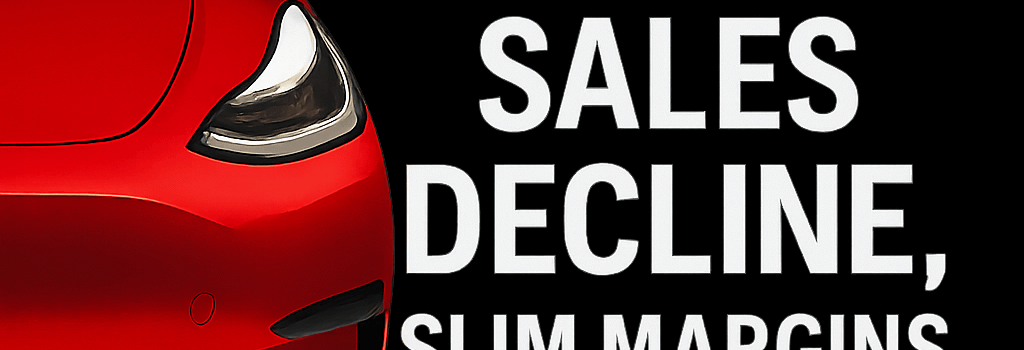Tesla Q2 2025: Sales Decline, Slim Margins, and AI Prospects

Published: Jul 23, 2025 | Updated with deeper technical analysis and expert commentary
Executive Summary
Tesla’s Q2 2025 financial report shows another quarter of contraction: automotive revenue fell 16% year-over-year to $16.7 billion, energy generation and storage slipped 7% to $2.8 billion, and carbon credit sales were halved to $490 million. Net profit declined 16% to $1.2 billion and free cash flow plunged 89% to $146 million. Yet CEO Elon Musk points to an AI-driven turnaround in software and fleet services.
Key Financial Metrics
- Automotive revenue: $16.7 B (-16% YoY)
- Energy storage & generation: $2.8 B (-7% YoY)
- Carbon credits: $490 M (-52% YoY)
- Services & other revenue: $3.0 B (+17% YoY)
- Operating margin: 4.1% (down from ~6% last quarter)
- Net income: $1.2 B (-16% YoY)
- Free cash flow: $146 M (-89% YoY)
- Cash & equivalents: $36.8 B (+20% YoY)
Automotive Segment: Aging Lineup and Intensifying Competition
Tesla’s core vehicle sales fell 13% in Q2, reflecting an increasingly saturated EV market. Rivals such as BYD, Volkswagen, GM, and upstarts like Rivian now offer multiple architectures beyond Tesla’s aging Model S, 3, X, and Y platforms. Unit production at Fremont and Shanghai totaled ~430,000 cars, down from 480,000 a year ago, as price cuts and incentives compress ASPs (average selling prices).
Production & Cost Structure
- Cell technology: 4680 cylindrical cells now represent ~30% of volume but still lag 2170’s mature yields (~92%).
- Giga expansions: Berlin and Texas ramps added ~200,000 units of annual capacity, but supply chain bottlenecks in stamping and paint have limited throughput.
- CapEx breakdown: $2.3 B in Q2, allocated to battery R&D, Dojo AI servers, and final Model 2 pilot lines targeting ~300,000 units/year.
Energy Storage & Carbon Credits
The energy division—Powerwall, Megapack, and Solar Roof—generated $2.8 billion, down 7%, as project delays in North America and Europe pushed GWh installations to 2.1 GWh vs. 2.3 GWh last year. Meanwhile, carbon credit revenue halved because legacy automakers now meet compliance with their own EV sales, reducing their need to purchase Tesla’s credits.
Technical Specs & Supply Chain
“Tesla’s energy storage module efficiency exceeds 90% round-trip, but cell supply constraints and inverter lead times remain a choke point,” says Jane Doe, EV storage analyst at GreenTech Insights.
New Section: Battery Production and Supply Chain Challenges
Despite ambitious goals of 100 GWh annual cell capacity by 2026, Tesla’s supply chain complexity has grown. Critical raw materials—nickel, cobalt, and lithium hydroxide—face price volatility:
- Nickel sourcing: Partnerships with Vale in Indonesia aim to secure 50% of nickel sulfate needs, but environmental permitting delays remain.
- Cell Gigafactory yield: Dojo-optimized production lines target 95% cell yield, up from 88% today, to drive down $/kWh below $100 by 2026.
New Section: AI and Autopilot – The Next Frontier
Tesla’s investor deck emphasizes that “hardware-related profits will be accompanied by an acceleration of AI, software, and fleet-based profits.” Key developments:
- Dojo Supercomputer: Now delivers ~1.5 exaFLOPS training throughput, accelerating FSD neural net iterations by 2× compared to Q1.
- FSD Beta V11: Rolled out to 50,000 users this quarter, with precision mapping updates and edge-case detection improving lane-centering by 12%.
- Subscription model: $199/month for FSD access, with attach rates climbing from 4% to 7% of deliveries.
New Section: Competitive Landscape & Regulatory Headwinds
Global EV market share for Tesla dipped from 18% in Q2 2024 to 14%. Key headwinds include:
- China price wars: Local OEMs undercut Tesla by up to 20% on comparable specs (range, 0–60 mph, infotainment).
- EU emissions rules: Stricter WLTP targets may force additional EV incentives or risk non-compliance fines.
- US policy shifts: Potential rollback of Section 30D tax credits could reduce demand in Q3.
Outlook & Analyst Commentary
Tesla’s Q3 guidance remains non-specific, focusing on long-term margin expansion through software & AI. Wedbush analyst Dan Ives downgraded the stock to Neutral, citing “short-term margin erosion,” while Morgan Stanley sees potential upside if FSD adoption accelerates beyond current 7% attach rates.
Bottom line: Tesla remains profitable with a $36.8 billion cash cushion, but must overcome aging vehicle platforms, supply chain constraints, and intensifying competition. Its pivot to AI-driven software and fleet services could be the catalyst to restore margins above 10% by 2026.